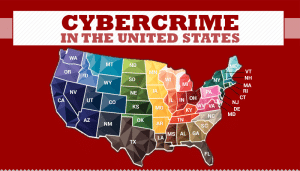Learn about the most common types of cybercrime and why Californians are especially at risk.

California a Key Target for Cybercrime
Californians need to be especially careful to guard against cybercrime while carrying out their daily activities online. California led the nation in cybercrime losses in 2013, with over $1 billion lost from businesses and individuals. Part of this figure is likely due to the fact that California is the most populous state in the country. However, the fact that many cybercriminals operate out of California is likely another significant factor. A ThreatMatrix study found that Los Angeles is #4 in the top 10 cities for online fraud origination in the US.
Types of Cybercrime Affecting US Companies
As people spend more time online, businesses are also moving online in order to better reach and serve their customers. This of course puts them at risk for cybercrime attacks. Here are some of the most common types of cybercrime attacks affecting US companies and the percentage of financial loss attributed to them by percentage.
Botnets (5%): A botnet is a network of computers that are all engaged in the same illicit activity, typically without the owner’s knowledge. Botnets are most often used to send spam and spread viruses.
Viruses (5%), Malware (7%), & Malicious Code (21%): Malicious software code can be installed without your knowledge while opening email attachments or downloading files from an unknown source. The purpose of the code is often to give the cybercriminal access to the computer for possible data theft or electronic money theft.
Malicious Insiders (8%): Insider theft is always a risk in a business, and unfortunately sometimes insiders use their access to company systems to commit crimes.
Stolen Devices (9%): When a company blackberry or laptop gets stolen, this may provide an opportunity for trade secret theft, data theft, or electronic money theft.
Phishing & Social Engineering (11%): Remember that old Nigerian prince and his lost millions that only you could help him recover? That was an early sort of phishing attack in which the cybercriminal attempted to get the target to voluntarily provide their bank account information or other personal data. Today’s phishing techniques are much more sophisticated and involve tricking users into visiting fraudulent copies of legitimate websites.
Web-Based Attacks (13%): As the name suggests, any kind of attack delivered via the web would qualify as a web-based attack. Such attacks often target vulnerabilities in operating software, browser software, or router software.
Denial of Service (21%): Sometimes called a DoS attack, a Denial of Service attack harms a business by making its computer network resources unavailable to authorized users. This could be done through a server overload.
If you stand accused of any of the above types of cybercrime, you can get help building the strongest possible defense from Chambers Law Firm. Don’t hesitate to call.




